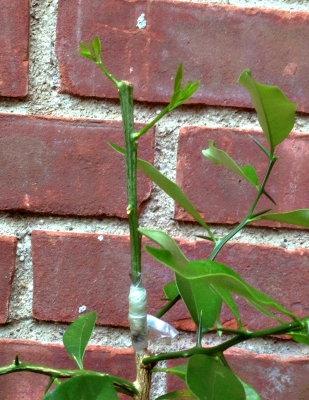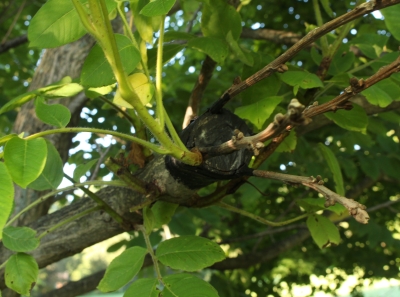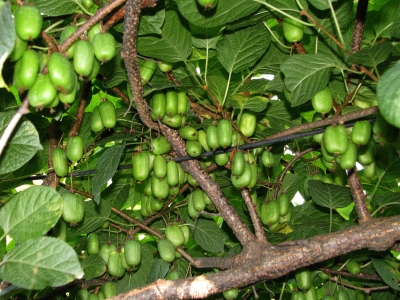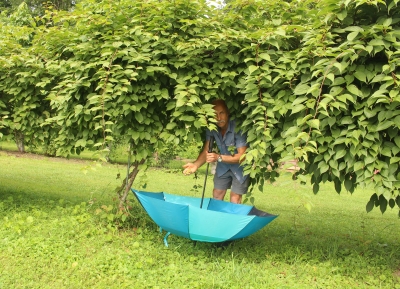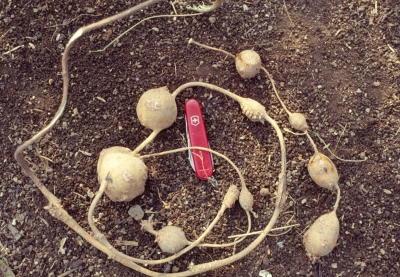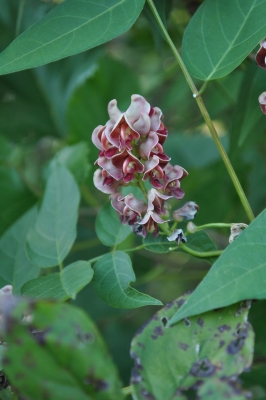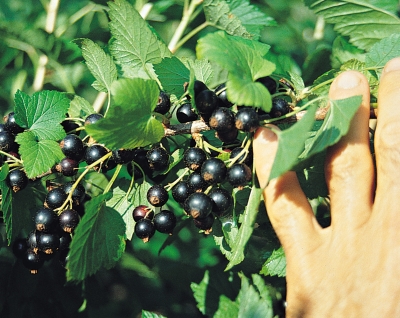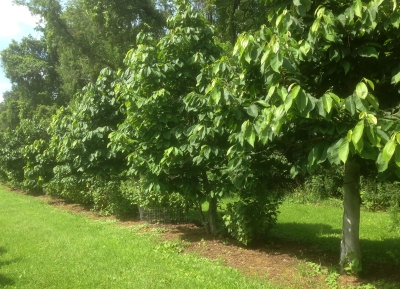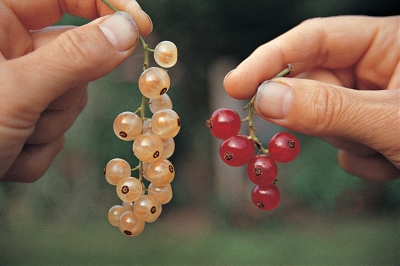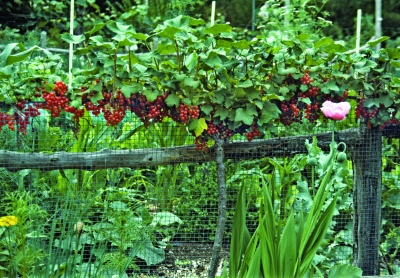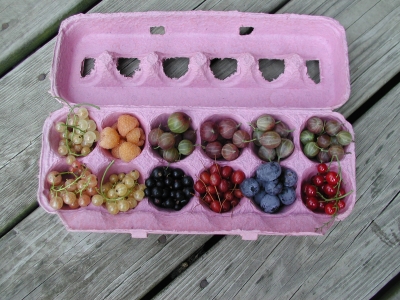SPROUTS MAKE ME HAPPY, DARWIN DOESN’T
/1 Comment/in Fruit, Gardening, Vegetables/by Lee ReichMore Citrus in the Making
You wouldn’t think that a couple of small, green sprouts could elicit so much excitement. Especially this time of year, with vigorous, green shoots sprouting up all over the place. But they did, in me. Not that anyone else would notice the two sprouts.
The sprouts were from grafts I made a couple of months ago. Over the years I’ve done hundreds of successful grafts; these two were special.
The first was citrus, special because the trees are subtropical and evergreen. The many apples, pears, and plums that I’ve grafted over the years are deciduous. I graft them when they are leafless and just about ready to start growing. Because the grafts are leafless, the wood, as long as the graft union is sealed, won’t dry out.
Not so for citrus, more specifically for the stems I clipped off my potted Golden Nugget tangerine tree. What was needed, then was a rootstock on which to graft that stem. The result would be a Golden Nugget plant above the graft (which stays right where it is no matter how much the plant grows). Clipping all the leaves from the stem forestalled moisture loss.
My home is also home to kumquat, another citrus that lives in a pot here, outdoors in summer and in a sunny window in winter. A couple of February’s ago, I glanced down at the kumquat seeds I had just spit out from fruits I harvested and ate. Not being able to squander their potential, I planted them in pots. A decade might have gone by before they were old enough to bear fruit but, after two years, the pencil-thick stems were large enough for grafting.
With kumquat rootstocks poised for the operation and Golden Nugget scions (the stem to be grafted atop the rootstock) stripped of leaves and also ready, the procedure was the same as for apple trees and other deciduous plants: matching, sloping cuts on rootstock and scion held in place by a wrapping with a rubber strip; covering the wound to prevent moisture loss. My usual choice of covering is Tree-Kote, which gets painted on, or Parafilm, a stretchy film that adheres to itself.
The citrus scion was fleshy enough to also lose moisture right through the bark. To prevent this, I wrapped the whole scion in the Parafilm. A blackened scion had followed previous attempts at grafting citrus without wrapping the stem.
A week or so ago, it was time to unwrap the Parafilm from around the stem. If the grafted parts were going to knit together, they should have done so by then. Lo and behold, a small, green sprout soon pushed out from the top bud of the scion.
Nutty Grafting
Not all deciduous trees are as easy to graft as apple and pear. Nut trees in the Juglandaceae family, which includes black walnuts, English walnuts, butternuts, pecans, and hickories, are notoriously difficult. Part of the reason is because cutting a stem in spring, which is, of course, unavoidable when grafting, makes these trees bleed, messing up the works.
With a slew of failures at grafting this family under my belt, I needed to try again. The candidate this year was a nut tree called buartnut, and hybrid tree with a hybrid name, the latter a non-euphonious combination of the words “heartnut” and “butternut.” Heartnut is a Japanese species of walnut, notable mostly for how easily it cracks to yield two heart-shaped nutmeats. Butternut is a richly flavored nut borne on a native tree that is becoming increasingly rare because of a blight disease.
Buartnuts allegedly need cross-pollination to bear nuts. My tree, large and spreading though only about 15 years old, lacked a mate. The mate needn’t be a whole other tree; a branch from another tree, grafted on my tree, would suffice and avoid the need to plant a whole new tree or wait the years it would take to flower. Grafted branches bear much more quickly than new trees.
Fortunately, I knew of another buartnut tree that could provide pollination. Last winter, I clipped off a few of its stems, packed them in a plastic bag, wrapped the bag in a wet towel, and then packed that whole mess into another plastic bag and then into the refrigerator. There, they remained hydrated and dormant until needed.
The key, I’ve been told, to grafting Juglandaceae, is to wait in spring until a spate of 80 degree plus weather is predicted. Conditions seemed right on a day last May. Because of past failures, I attempted numerous grafts, three different kinds: the bark graft, the banana graft, and the whip graft. To promote bleeding off-site rather than at the grafts, I slit stems below the grafts. I covered one of the bark grafts with a plastic bag and then, for shade so the stems wouldn’t cook, a paper bag.
Almost all the grafts failed. Except one. Just one stem of just one of the bark grafts (each of these bark grafts carries 4 or 5 stems) sprouted. How exciting!
Temple Disruption
Exciting goings-on in the blueberry patch also. Birds are flitting about every morning, enjoying a few berries despite our repeated efforts to secure any openings in the walk-in “Blueberry Temple.” I threaded some string to more tightly join the top and side netting. As previously, I think this will solve the problem.
Then again, this may be a Darwinian experiment. Birds never used to work their way into the Temple. Openings in the top netting are 1” across; I fear the net is breeding for smaller models of cedar waxwings and catbirds. Or perhaps smarter ones better at finagling their way to the blueberries
DUCKS WORKING, BUT NOT ON GROUNDNUTS
/9 Comments/in Fruit, Gardening, Pests, Vegetables/by Lee ReichTHE DUCKS CALL THIS “WORK”?
My ducks told me that the hardy kiwifruits were ripe. No, they’re not trained to give a specialized “hardy kiwifruit ripe” quack. Instead, they’ve taken to hanging out beneath the vines to scoop up dropped fruits. No training needed for this.
Those dropped fruits are one reason that these vines — Actinidia kolomikta — are not as popular for fruit as another species, Actinidia arguta. Ripening, and dropping, is fast in the heat of July. Arguta kiwis ripen in late summer and early fall, and possibly cling to the vines more reliably then because cooler weather slows ripening.
Not that either of the fruits are well known. Both are cousins to the fuzzy kiwis (A. deliciosa), ubiquitous in supermarkets. Both hardy kiwis differ from the fuzzies in being cold-hardy (only to 0°F for the fuzzy as compared to minus 30°F for A. arguta and to minus 40°F for A. kolomikta), grape-sized, with smooth, edible skins, and better flavor than the fuzzies.
In addition to ripening earlier and dropping more readily, kolomikta kiwis differ from arguta kiwis in coming into bearing much sooner, often in their second year, and growing much less rampantly. Argutas are hard vines to tame. Ornamental vines of both species gracing historic gardens for decades before their fruits were noticed and appreciated is testimonial to their beauty. Kolomikta’s leaves are brushed silvery white with random pink blushes.
Back to harvest. Harvest from the ground is unfeasible because the green fruits are too hard to find among the blades of green grass. And unhealthy because of all the processed kiwifruits — poop — the ducks eject at their far end as they gobble up the berries. A ground cloth to catch the berries would become similarly soiled unless I went to the trouble of spreading it, shaking the vines, then gathering up the cloth after gathering up the fruits.
Instead, I’ve taken to walking beneath the vines with a large umbrella, upturned, and shaking portions of the vines right above the umbrella. Ripe fruit drop into the waiting “funnel.” Sure, many fruits are lost, but the vine bears more than enough to share with the ducks, who can enjoy the missed fruits.
RIPENING OFF THE VINE, HOW CONVENIENT
Like apples, bananas, and avocados, kiwifruits of all stripes are climacteric fruits. Instead of steady ripening, climacteric fruits, just before they are ready to eat, go through a burst of ripening with sugar levels and carbon dioxide production all of a sudden rapidly increasing. Fruit quality begins to decline right after this burst.
Ethylene, a simple gas that is also a naturally occurring plant hormone, also spikes during this burst. And ethylene further accelerates ripening, which increases ethylene production even more, which increases ripening even more, and . . . Disease, wounds, and decay also stimulate ethylene production, which is why “one rotten apple spoils the barrel.”
If picked when sufficiently mature, but not dead ripe, kiwifruits store well for a few weeks. They’ll ripen during storage, slower under refrigeration, faster at room temperature. From experience, I know that “sufficiently mature” for kiwis is when the first fruits start ripening. So, in addition to my umbrella harvesting, I’m harvesting a bunch of the unripe fruits and refrigerating them to extend their season. Don’t worry; there’ll still be plenty for the ducks.
SOMETHING FOR YOU PERMACULTURALISTS
Every time I walk back to the kiwi vines, I pass a perennial flower bed. Or, at least, what was supposed to be a flower bed and now is bordering on half flowers and half weeds. The major two weeds, I admit, are my own doing.
The first of these weeds is dayflower, which arrived here with some bee balm plants from a friend. It’s actually a pretty plant with small, blue flowers, and it’s easy and satisfying to pull out. To a point.
The other weed, groundnut, was a deliberate planting, by me, about 20 years ago. It seemed interesting, bearing edible, golf-ball-sized tubers that string along underground like beads. Groundnut reputedly is the food that got the pilgrim’s through their first winter. Occasionally the plant, a vine, flowers, bearing chains of pale chocolate-colored blossoms. Do I remember them smelling like chocolate also? Perhaps. With all the other vegetation in the bed, the plants haven’t flowered in a long time.
The problem is that those chains of tubers spread to make more chains of tubers which, in turn, do likewise, ad infinitum. The vines now creep over almost every plant in that bed but rarely get enough space to themselves to make tubers anymore. No matter. They didn’t taste that good anyway.
I wasn’t as foolish as might seem planting groundnut in that flower bed. Twenty years ago that flower bed wasn’t a flower bed, but just a place for interesting plants in my then small garden.
SO MANY FRUITS, SO LITTLE . . . ?
/5 Comments/in Books, Fruit, Gardening/by Lee ReichHow Can Something So Nutritious Taste So Good?
Black currants are a berry brimming with vitamin C (in comparison, oranges are like water) and other health goodies, with an intense, rich, to me resin-y flavor that pairs well with dark chocolate or, on bread, with peanut or any other nut butter. Not everyone enjoys the fresh flavor, but that’s okay. Not everyone needs to enjoy every kind of fruit.
What the doyen of horticulture, Liberty Hyde Bailey, wrote almost 100 years ago about apple varieties also applies to fruits in general: “Why do we need so many kinds of [fruits]? Because there are so many folks. A person has a right to gratify his legitimate tastes . . . There is merit in variety itself.”
With that said, just about everyone does like black currants once they’ve been cooked and sweetened to make jam, juice, pie, and the like, or soaked in alcohol to make a liqueur (créme de cassis). My preference is for the raw berries, eaten straight up, in my cereal, or smooshed on bread as an instant jam.
Black currants have more to recommend them than only good flavor. In contrast to most fruit plants, they fruit well in shade. Look down my row of pawpaw trees, and in the shade between every two of them you’ll see a black currant bush thriving. In contrast to just about every other plant, black currants are deer resistant. My ducks and chickens, as well as wild birds, leave the berries alone.
In fact, few significant pests attack the plant or the fruit — except for a disease called white pine blister rust. This disease needs two different host plants to complete its life cycle, a susceptible variety of currant or gooseberry, and a white pine. Because the disease can kill white pines, an important timber crop, gooseberries and currants were once banned by federal law. That’s no longer the case, one reason being that most cultivated varieties of gooseberries and currents are not very susceptible to the disease.
Black currant is very susceptible to the blister rust disease — except for some rust-resistant or immune varieties. The first of these, Consort, Crusader, and Coronet, developed in the middle of the 20th century, were not very tasty just popped into your mouth raw. Newer rust-resistant varieties, such as Belaruskaja and Titania, are delicious any which way, and along with blueberry are my favorite fruits.
Bye, Bye, Black Currants
Sad to say, black currants are finished for the season. That’s their one deficiency: They come and go too quickly. Still, bags stuffed full of black currants are now in the freezer, not to be opened until Christmas.
And I can’t complain. Branches of blueberry bushes are bowed to the ground under their weight of fruit, and will continue to do so until almost the end of summer. And gooseberries still have a a week or so more of fruiting. Mulberries, too, have a few more weeks, except that the birds are eating most of them.
Red, pink, and white currants started fruiting with the black currants, and will hang in good eating condition for weeks to come. Red, pink, and white currants are different varieties of the same fruit (like Red Delicious and Golden Delicious apples), a different species and quite different in flavor and bearing habit from black currants. Most of the reds, whites, and pinks will hang from the branches for weeks because the berries, looking like shiny, translucent chains of beads, the seeds visible seemingly floating within when backlit by the sun, are almost too pretty to harvest. Also, not being my favorite fruits, they get to hang without being picked, especially with the abundance of other, tastier (to me), berries, an opinion that might change if I had some skill in jelly-making.
I’m an Amateur, for Sure
Liberty Hyde Bailey would be proud of the abundance and variety of fruit here. That’s one great advantage of planting your own: You get to choose what pleases your palate as far as kinds of fruits and varieties of fruits, and you get a hedge against a poor harvest from one or a couple of fruits any year. Hence the Macoun and Hudson’s Golden Gem apples here, the grapes, and gooseberries (a dozen varieties of each), gumis, raspberries, kiwis, seaberries, and elderberries, among many other fruits.
Again, quoting Liberty Hyde Bailey: “We give the public indifferent fruits, and thereby neither educate the taste nor stimulate the desire for more . . . Just now [1922] we are trying to increase the consumption of apples . . . it cannot be accomplished by customary commercial methods. To eat an apple a day is a question of affections and emotions.”
Professor Bailey had great faith in the role of the hobbyist, the amateur (in the true meaning of the word, the lover) in fruit growing. Try it.
One route to cultivating a greater appreciation for fruit and know-how for growing them is to join North American Fruit Explorers, a band of fruit “nuts” drawn from both academia and backyards, but all amateurs. For more information about some lesser know fruits, including black currant, I recommend my own book, Uncommon Fruits for Every Garden.

